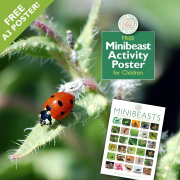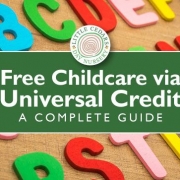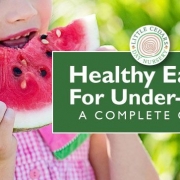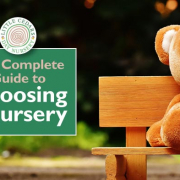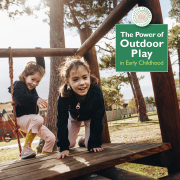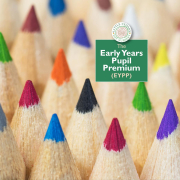Bird Feeders: a Creative ‘Nature’ Activity for Kids
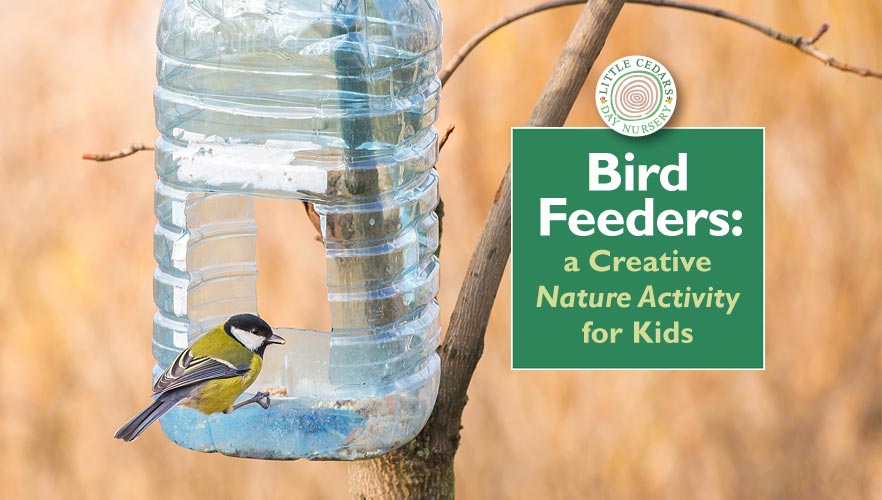
 A wonderful way to encourage young children to enjoy and learn from nature is for parents to help them make bird feeders. There are many ways to approach this creative, fun activity and it’s sure to result in lots of our feathered friends visiting. Birds are delightful creatures that are simply a joy to see and hear. They will also greatly appreciate the extra food, particularly at times of the year when it’s more scarce or when they have little mouths to feed. So, this is an activity that’s a win for everyone! Some birds may even become regulars if the food is topped up. In fact, we’ve given some of our own visiting birds names as they now come every day and even stare through the window at us when food needs topping up! With all this in mind, today, we take a look at some of the simple ways children can make home-made bird feeders to encourage birds to visit. Take a look and see how easy and creative the activity can be.
A wonderful way to encourage young children to enjoy and learn from nature is for parents to help them make bird feeders. There are many ways to approach this creative, fun activity and it’s sure to result in lots of our feathered friends visiting. Birds are delightful creatures that are simply a joy to see and hear. They will also greatly appreciate the extra food, particularly at times of the year when it’s more scarce or when they have little mouths to feed. So, this is an activity that’s a win for everyone! Some birds may even become regulars if the food is topped up. In fact, we’ve given some of our own visiting birds names as they now come every day and even stare through the window at us when food needs topping up! With all this in mind, today, we take a look at some of the simple ways children can make home-made bird feeders to encourage birds to visit. Take a look and see how easy and creative the activity can be.
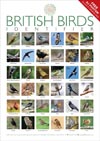 Combine with our Bird-Spotting Activity
Combine with our Bird-Spotting Activity
Children can combine this bird feeder activity with the bird-spotting activity that we published separately (including a free bird-spotting poster to download). Bird feeders are a great way to attract birds and children will find the activity even more fun and educational if they can start to recognise and name the types of birds they see.
The Quickest & Most Simple Bird Feeder
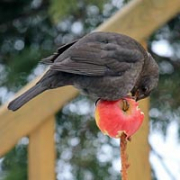 The fastest and easiest bird feeder for children/families to make is simply an apple. This can either be hung with string from a tree branch, bush, or similar, or the apple can be ‘spiked’ on the pointy end of a tree branch, a strong twig or something like a bamboo pole embedded in the ground (so long as it’s tall enough to keep birds safe* from predators). Easy! We suggest stripping some of the apple skin off to expose the flesh. Apples are a particular favourite of blackbirds and bluetits, amongst others.
The fastest and easiest bird feeder for children/families to make is simply an apple. This can either be hung with string from a tree branch, bush, or similar, or the apple can be ‘spiked’ on the pointy end of a tree branch, a strong twig or something like a bamboo pole embedded in the ground (so long as it’s tall enough to keep birds safe* from predators). Easy! We suggest stripping some of the apple skin off to expose the flesh. Apples are a particular favourite of blackbirds and bluetits, amongst others.
Tip!
Don’t worry if birds do not come right away after you’ve put out your bird feeder. Birds and most wild animals are suspicious of any changes, so it may take a few days before they learn to trust the new feeder.
Monkey Nut Chains
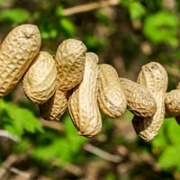 This is also a very easy bird feeder for children/families to make. All you need is some string and some monkey nuts* (peanuts still in their outer husk). A supervising adult will need to make some small holes in one end of each husk and then string can be threaded through to form a kind of chain (like a necklace). Monkey nuts can be threaded on to form the right length and then this can be tied between the branches of a tree, or similar. See our note about safely locating* them, though.
This is also a very easy bird feeder for children/families to make. All you need is some string and some monkey nuts* (peanuts still in their outer husk). A supervising adult will need to make some small holes in one end of each husk and then string can be threaded through to form a kind of chain (like a necklace). Monkey nuts can be threaded on to form the right length and then this can be tied between the branches of a tree, or similar. See our note about safely locating* them, though.
Home-made Seed Cakes
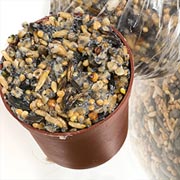 Home-made seed cakes are another type of bird feeder that is both easy and fun for children to make. Basically, they consist of lots of seeds mixed into a ‘cake’ made from either suet* or lard*. The seeds are mixed in when the lard or suet is melted, so parents/adults will need to help with that part as it’s done by heating it in a saucepan. Once melted, the seeds can be added and mixed in. Once cool enough to be safe, the children can take over to make most of the feeders. First, a piece of string can be tied from the centre of the base of something like a flower pot or yoghurt pot (parents should make the hole, if needed). Then the child can mould the seed cake into the pots, or other similar plastic containers. Once cooled, the seed cakes will harden and can then be suspended from the branches of a tree, bush, fence post or under the eaves of a house or outbuilding. Bluetits, great tits, starlings and robins will usually be the first to try out the new cakes.
Home-made seed cakes are another type of bird feeder that is both easy and fun for children to make. Basically, they consist of lots of seeds mixed into a ‘cake’ made from either suet* or lard*. The seeds are mixed in when the lard or suet is melted, so parents/adults will need to help with that part as it’s done by heating it in a saucepan. Once melted, the seeds can be added and mixed in. Once cool enough to be safe, the children can take over to make most of the feeders. First, a piece of string can be tied from the centre of the base of something like a flower pot or yoghurt pot (parents should make the hole, if needed). Then the child can mould the seed cake into the pots, or other similar plastic containers. Once cooled, the seed cakes will harden and can then be suspended from the branches of a tree, bush, fence post or under the eaves of a house or outbuilding. Bluetits, great tits, starlings and robins will usually be the first to try out the new cakes.
A Word About Seeds & Cheese
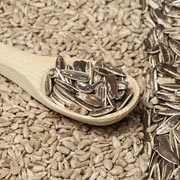 Your choice of seeds directly affects the success – or otherwise – of your bird feeders. While many commercially-available seed mixtures contain several different types of seed, we have found that birds ignore some of them, so they go to waste. Our own bird feeders have been far more popular when they use more sunflower ‘hearts’ (the sunflowers without the other case) and less of the wheat and barley type seeds. Crushed peanuts* are also popular, but see our notes below about the safety of both baby birds and children when it comes to nuts.
Your choice of seeds directly affects the success – or otherwise – of your bird feeders. While many commercially-available seed mixtures contain several different types of seed, we have found that birds ignore some of them, so they go to waste. Our own bird feeders have been far more popular when they use more sunflower ‘hearts’ (the sunflowers without the other case) and less of the wheat and barley type seeds. Crushed peanuts* are also popular, but see our notes below about the safety of both baby birds and children when it comes to nuts.
TIP: birds like robins, starlings, wrens, dunnocks and blackbirds also adore grated (mild) Cheddar cheese, but ensure you only put out a little at a time. Don’t give them too much because, although they love it, it should only be given as an occasional treat, not a main meal. It’s also important never to let it go mouldy; mould can kill birds, which is also a reason never to give them blue or veined cheese.
Pine Cone Bird Feeders
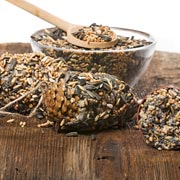
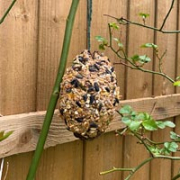 Another type of bird feeder that is both fun and easy to make is a pine cone feeder. All you need is a big pine cone, ideally with the cone splines open, a birdseed mixture and either peanut butter*, suet* or lard*. All your child needs to do is paste the peanut butter (or suet or lard that’s been safely warmed to soften it) all over the pine cone, including into the open splines. Then the whole thing can be rolled over your seed mixture, so the seeds stick all over the pine cone. Once complete, the pine cone feeder can be hung with a piece of string in an appropriate place outside. Even better: hang several together so the birds can’t miss them. The birds will love pecking them when they’re hungry.
Another type of bird feeder that is both fun and easy to make is a pine cone feeder. All you need is a big pine cone, ideally with the cone splines open, a birdseed mixture and either peanut butter*, suet* or lard*. All your child needs to do is paste the peanut butter (or suet or lard that’s been safely warmed to soften it) all over the pine cone, including into the open splines. Then the whole thing can be rolled over your seed mixture, so the seeds stick all over the pine cone. Once complete, the pine cone feeder can be hung with a piece of string in an appropriate place outside. Even better: hang several together so the birds can’t miss them. The birds will love pecking them when they’re hungry.
Carton Bird Feeders
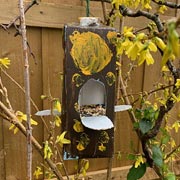 Bird feeders made from recycled cartons can be great fun, fairly easy and can be quite creative. All you need is an empty milk or juice carton, by which we mean the card ‘Tetra Pak’ type, plus some bird seed/food and some string. Parents will need to help younger children safely attach the string to the tops of the cartons and cut flaps/openings into the sides of the carton. These can be folded down, as shown in the photo, and suspended outside somewhere suitable for the birds. For extra creative fun, children can first paint patterns, designs or even faces on the cartons. This type of bird feeder is great because it not only holds the bird food but also potentially gives birds somewhere safe to land while feeding. As they were originally for holding liquid, they can alternatively be used to hold drinking water for birds — or perhaps children can make one for food and another for drinking water.
Bird feeders made from recycled cartons can be great fun, fairly easy and can be quite creative. All you need is an empty milk or juice carton, by which we mean the card ‘Tetra Pak’ type, plus some bird seed/food and some string. Parents will need to help younger children safely attach the string to the tops of the cartons and cut flaps/openings into the sides of the carton. These can be folded down, as shown in the photo, and suspended outside somewhere suitable for the birds. For extra creative fun, children can first paint patterns, designs or even faces on the cartons. This type of bird feeder is great because it not only holds the bird food but also potentially gives birds somewhere safe to land while feeding. As they were originally for holding liquid, they can alternatively be used to hold drinking water for birds — or perhaps children can make one for food and another for drinking water.
Plastic Bottle Bird Feeders
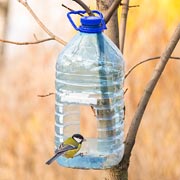
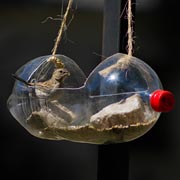 In a similar way, clear plastic bottles can be used as bird feeders or for water. The same approach can be used but flaps are not advised as they’re trickier for children to fold and also plastic bottles will have sharper edges than the carton approach above. So, this particular type of bird feeder needs extra supervision from a parent or adult. Take a look at the photos to see what’s possible, though. One photo (the first small image at the start of this article) even shows a plastic spoon that’s used as a landing platform and seed dispenser, all in one. Once finished, plastic bottle feeders tend to last a long time, so long as they’re regularly cleaned and refilled.
In a similar way, clear plastic bottles can be used as bird feeders or for water. The same approach can be used but flaps are not advised as they’re trickier for children to fold and also plastic bottles will have sharper edges than the carton approach above. So, this particular type of bird feeder needs extra supervision from a parent or adult. Take a look at the photos to see what’s possible, though. One photo (the first small image at the start of this article) even shows a plastic spoon that’s used as a landing platform and seed dispenser, all in one. Once finished, plastic bottle feeders tend to last a long time, so long as they’re regularly cleaned and refilled.
*Bird Safety & Well-being
| Peanut butter, if used, should be free of salt, sugar and flavouring. During breeding season (Mar-Aug) it should be smooth, so it’s safe for baby birds. | Peanuts and monkey nuts, if used, should be unroasted and clear of any fungus (break open the outer husk/check the nut surface). Do not touch or use if present. | Suet, if used, should be beef suet i.e. from cows. It should be hard and crumbly, not soft and squeezable. Other suets may not be safe for birds. |
| Lard, if used, should be pure lard. It should remain hard even in warmer weather and should not be squeezable. It is unsafe for birds if it melts in the sun. | Locating your bird feeder is important. To keep birds safe from predators, site at least 1.5m above ground and under the overhang of trees/bushes or eaves. | Change bird drinking water and clean bird feeders regularly to avoid spreading disease or bacteria amongst the birds. See RSPB guidelines, available here. |
**Child Hygiene & Safety
This article was brought to you by Little Cedars Nursery, Streatham. We hope that it was useful and that you and your little one(s) enjoy the suggested activities.
Little Cedars: a First Class Nursery & Preschool in Streatham
Little Cedars is a great choice for families looking for high-quality childcare in Streatham or near Furzedown, Tooting, Balham, Norbury or Colliers Wood

 Are you searching for the best nursery or preschool for your child in Streatham? Let us show you and your little one around and we’re sure you’ll soon see how well they would fit in. We offer children under five the very best start in life in a well-equipped, expertly staffed, home-from-home environment.
Are you searching for the best nursery or preschool for your child in Streatham? Let us show you and your little one around and we’re sure you’ll soon see how well they would fit in. We offer children under five the very best start in life in a well-equipped, expertly staffed, home-from-home environment.
Apply for a nursery place, book a tour or get answers to any questions by selecting an option below:
Little Cedars may also be conveniently located if you are looking for nurseries/preschools near Streatham Hill, Streatham Park, Streatham Common, Furzedown, Tooting, Tooting Bec, Tooting Broadway, Tooting Common, Balham, Norbury or Colliers Wood.

